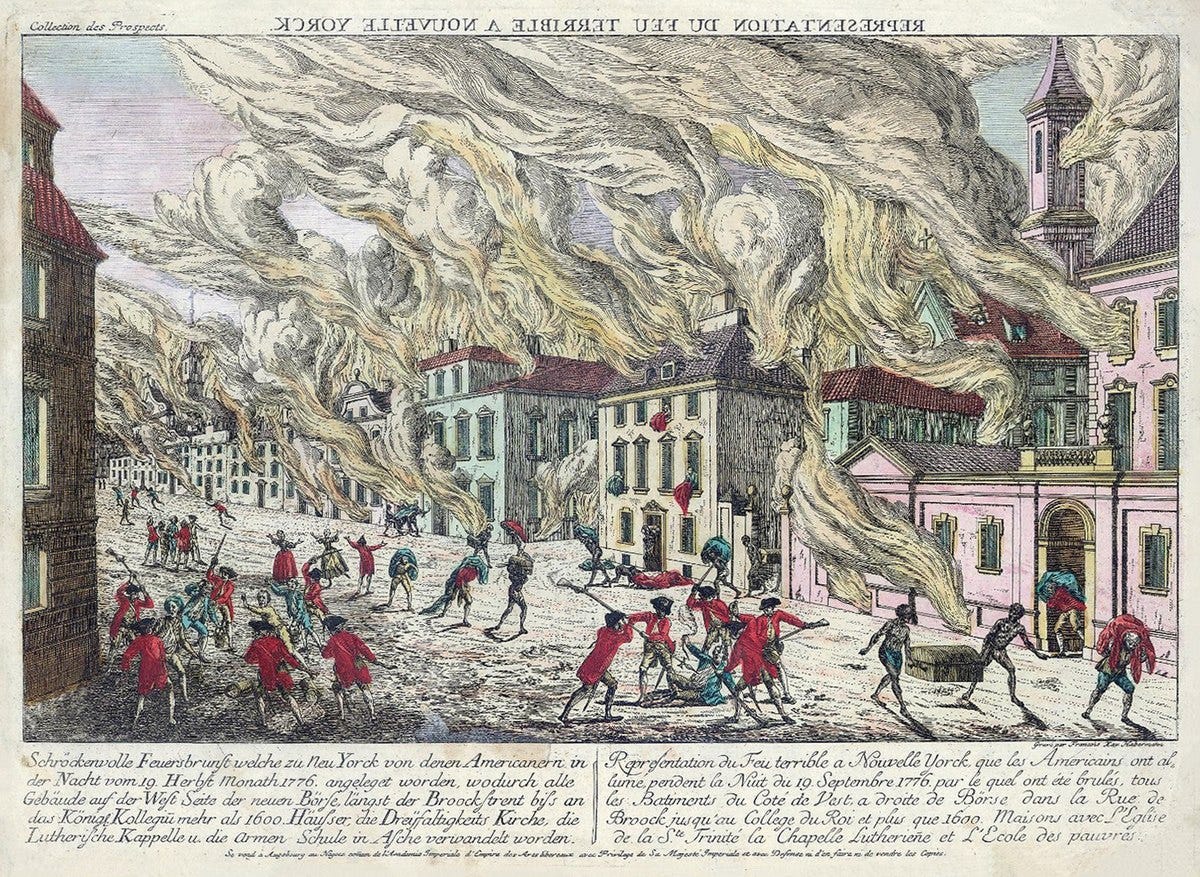TDIH: New York City Burns
Did George Washington set the fire on purpose? The British thought so.
On this day in 1776, New York City burns. Did George Washington set the fire on purpose? The British thought so. General William Howe later wrote that “a most horrid attempt was made by a number of wretches to burn the town of New-York . . . .” For his part, George Washington apparently had no idea who had done it. Instead, he gave credit to “Providence—or some good honest Fellow.”
Of course, if Washington had gotten his way, then the fire would have been set days earlier, when he’d first been forced to abandon the city. Why should he leave behind such “warm & comfortable Barracks” for the British? He’d asked Congress for permission to torch the city, but he’d been denied. The decision, he thought, was “amg one of the capitol errors of Congress.”
The City of New York was not at its best in those days. Much of Washington’s army had come to the city after a crushing defeat at Brooklyn Heights. As the army arrived, many Loyalists abandoned the city and the Continental Army took over. Unfortunately, it wasn’t too long before the British drove Washington out of New York as well.
Washington might have been forbidden to torch New York, but he wasn’t going to just leave supplies ready and waiting for the British, either. Supplies were thrown in the river or burned. Church bells were carried away as a “necessary tho’ unfortunate resource for Supplying our want of Cannon.”
Of course, those bells were also typically used as fire alarms. Later, one British official would note that no bells were available to ring on the night of the big fire. The situation led many to believe that “Mr. Washington was privy to this villainous act as he sent all the bells of the churches out of town under pretense of casting them into cannon.”
The fire began the night of September 20-21, almost a week after the Americans had left. It had been dry, and it was windy that night. The fire escalated quickly. Building after building were soon ablaze. The steeple of one church was said to be a “pyramid of fire.” One observer later wrote that the “sick, the aged, women and children, half naked were seen going they knew not where. . . . The shrieks and cries of the women and children . . . made this one of the most tremendous and affecting scenes I ever beheld.”
In the end, as many as 600 buildings would be destroyed before the fire could be extinguished. Charred out remains of some buildings would remain throughout the British occupation of New York, a constant reminder of that awful night.
Perhaps they were also a constant reminder of something too often forgotten today. Yes, our forefathers were definitely fighting a Revolution against a tyrannical British government. But sometimes they were also fighting a civil war against their own fellow citizens, who did not share their views.
Did Loyalists not care that their freedoms were being trampled? Were they unable to see the infringement on their liberty? Or perhaps they saw the problems, but hoped that the situation would right itself.
Either way, the City of New York seems to have been just one of many to get caught in the crossfire during those long revolutionary war years. Some Loyalists might have been content to stay with the King, but the Patriots were more determined.
They had to be. After all, they were fighting for their liberty.
Sources can always be found on my website, here.





It would be no surprise to me if Washington set the fires to make it harder for the Red Coats to have supplies or barracks to stay in. That would be customary during war.
It’s too bad we didn’t do that in our terrible exodus of Afghanistan. Then again our current President has never had a real job or serve in the military, he has just been a life long politician. (Sorry for the political statement.)
❤️🇺🇸🇺🇸🇺🇸
The British never gave Washington the credit he deserved....